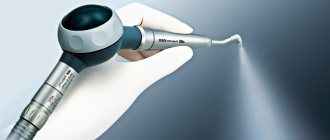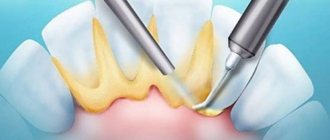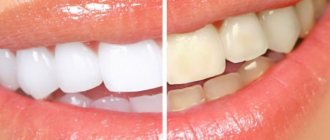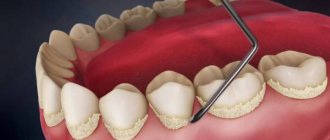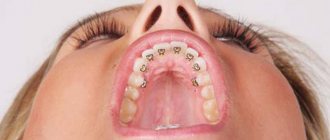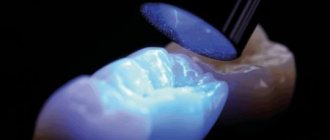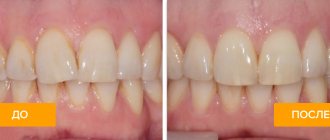What is tartar and what are the causes of its appearance?
Tartar is hardened plaque that forms on the visible part of the tooth (crown) and under the gum.
The reasons for its appearance are natural, but the consequences can cause pathologies in the oral cavity.
Initially, food particles stick to the enamel. Bacteria begin to actively multiply in them. A dental plaque is formed, which looks like a soft, light plaque. Plaque can be easily removed by regular tooth brushing. But if this does not happen, then food debris, dead cells of the mucous membrane, calcium and phosphorus salts from saliva are layered on the soft plaque. They crystallize and harden.
Mineralization occurs on average within 12 days. Soft plaque turns into hard plaque. Tartar has a rough surface, onto which more and more elements “cling.”
Attention: A bacterial film on teeth forms within 16 hours. Therefore, it is important to brush your teeth at least twice a day.
Photo of plaque, male jaw
Why hard deposits form
Plaque formation is inevitable, but there are a number of factors that accelerate the process:
- Irregular hygiene. Particularly active formation of plaque and stone occurs at night: salivation decreases, a person swallows less often, and does not move the tongue. This creates a favorable environment for bacterial growth.
- Poor hygiene. Brushing teeth with horizontal movements does not affect hard-to-reach areas. The interdental spaces should be cleaned by moving the brush vertically.
- Diet. A large amount of sweet and starchy foods leads to the sticking of carbohydrates to the enamel and the proliferation of pathogenic microflora. To reduce the rate of plaque formation, you should eat fresh, firm vegetables and fruits. Chewing the fibrous pulp for a long time partially helps remove plaque.
- Physiological features. Incorrect bite and crowded teeth make proper cleaning difficult.
- Metabolic disorders. The composition of saliva changes, its bactericidal properties decrease.
- Smoking. Cigarette tar settles on the teeth, causing the formation of films and plaques.
Advantages and disadvantages of ultrasonic cleaning
Advantages:
- Possibility of removing plaque even in interdental spaces
- Elimination of dark pigmentation from tobacco and food colorings
- Removing deposits from periodontal pockets
- Sterilization of the tooth surface from pathogenic microflora
- Lightening enamel to a natural shade
- Prevention of caries
- No risk of injury to teeth and gums
- Eliminates unpleasant odor caused by deposits
Flaws:
- Discomfort when treating sensitive areas (periodontal pockets)
- Increased sensitivity of enamel to hot and cold stimuli for several days
- A large number of contraindications
Why is ultrasonic cleaning necessary?
Professional teeth cleaning in a clinic identifies problem areas and helps avoid future diseases.
- Detects caries. The destruction of enamel and dentin can be hidden under a layer of tartar. If caries is discovered later, it should be cured.
- Prevents the formation of new caries, including those who wear braces.
- Prevents gum inflammation, periodontitis, exposed roots, bleeding, and bad breath.
- Prepares the oral cavity for surgery and implant installation. Removing colonies of bacteria living in dental plaque ensures the safety of manipulations that violate the integrity of tissues.
- Brightens teeth without aggressive chemical whitening.
Photos BEFORE and AFTER cleaning
Can restrictions be removed?
Thanks to the fact that many clinics in St. Petersburg conduct regular promotions aimed at attracting new patients, the price of hygienic teeth cleaning using ultrasound is affordable to almost everyone today. A mandatory component of the procedure is a preliminary examination, during which possible contraindications are identified. Additional treatment prescribed in such cases may increase the cost of the service, but it is a necessary condition.
Considering diagnosed viruses and infections as limiting factors is associated with concern for the health of not only the patient, but also the doctor. An organism susceptible to pathology is capable of responding inadequately to treatment - under the influence of ultrasonic waves, an increase in cellular metabolism is possible, so you should wait until complete recovery.
Limitations associated with heart disease, as well as the presence of pacemakers, are caused by the effect of ultrasound on the circulatory system. Heart rhythm disturbances pose a threat to human life, which leads to recommendations for choosing other methods of professional dental cleaning.
Doctors advise refraining from ultrasonic cleaning during pregnancy, as well as in the first months after the birth of a child. This is due to the sensitivity of the body, which increases at these stages - external influences can negatively affect the patient’s well-being, as well as provoke an unplanned reaction. An option recommended when planning a pregnancy is to carry out dental procedures a couple of months before conception, which allows you to avoid situations that require an urgent visit to the clinic.
Is ultrasonic teeth cleaning harmful?
Ultrasonic cleaning does not pose any threat to teeth and the body as a whole. An exception is situations in which the technology is broken or the patient has contraindications. Ultrasound can damage enamel if it is thinned or has such a structural feature. Sometimes brushing causes bleeding from the gums. The doctor will help stop it and advise what needs to be done for speedy healing.
Advice: to avoid possible troubles, before starting the procedure, the dentist finds out the state of health, concomitant diseases, and reaction to medications. Answer honestly and directly, every nuance matters.
Ultrasonic teeth cleaning in a dental clinic in Moscow – “Aesthetica”
We offer our patients a comprehensive oral hygiene service, which includes ultrasonic teeth cleaning and Air Flow removal of pigmented plaque. We carry out procedures using modern and highly efficient equipment, under magnification, which gives us the opportunity to achieve impeccable quality of teeth cleaning.
Our specialists pay close attention to grinding and polishing the teeth after the cleaning procedure. If you do not grind and polish your teeth after removing plaque, it will accumulate quickly and actively. After completing the comprehensive cleaning procedure, our hygienists will definitely introduce you to all the rules of caring for your teeth and oral cavity, and will help you choose the right tools for home hygiene.
You can sign up for a consultation with our specialists at any branch of the Aesthetica clinic in Moscow - in Barvikha or Podsosensky Lane!
Pros and cons of ultrasonic tartar removal
Unlike other methods, ultrasonic cleaning has a number of advantages:
- Removes subgingival calculus that is difficult to reach with traditional instruments. To clean the root zone, the doctor pulls back the gums and works with the neck and root of the tooth.
- Cleans the interdental spaces even of very dense teeth, uneven, overlapping one another.
- The procedure does not last long - 40-60 minutes.
- Painless. The patient does not feel any impact.
- Non-contact influence. Only air and water come into contact with teeth. With the outdated mechanical method, the instruments scratch the enamel and cause an unpleasant “grinding” sensation.
In what cases does stone plaque form?
The reason for the formation of tartar is poor quality dental care, in which soft plaque is not completely removed. High mineral content causes plaque to harden. Using a too soft toothbrush, lack of attention to the interdental spaces and gum margins, irregular oral hygiene, etc. are the main sources of the problem.
But there are factors that increase the likelihood of hard deposits forming on teeth:
- diseases of the digestive system and endocrine system, in which the chemical composition of saliva changes;
- malocclusions and dental defects that form particularly difficult areas to clean;
- wearing dentures, braces, brackets, plates and other structures that make it difficult to properly clean teeth using a traditional brush and paste;
- a large amount of carbohydrate foods in the diet, which facilitates the gluing of soft plaque particles.
Main stages of ultrasonic processing
The dentist conducts an examination, identifies places where tartar accumulates, the amount, and determines its density in order to choose the appropriate cleaning regimen. Sometimes teeth are treated with a special solution that reveals the boundaries of plaque. If the patient has sensitive teeth, gums or deep subgingival calculus, anesthesia (injection or application) is performed.
Stone removal is carried out in three stages:
Brushing teeth with a skyler
Skyler is a dental instrument that generates ultrasonic air vibrations. Water (an antiseptic solution) mixed with air is sprayed through a narrow nozzle. The liquid is intended to cool the tooth and wash away the separated plaque.
The ultrasonic wave forms cavities in mineralized deposits, the plaque cracks and peels off from the enamel. The fragments are removed with a saliva ejector.
First, the doctor cleans the crowns, then the subgingival area, guiding the scaler with parallel vertical movements.
Brushing teeth with a skyler
Polishing
Cleaned teeth have a rough surface. To slow down the adhesion of food and bacteria, polishing is used.
Main types:
- Mechanical with special paste and a round elastic brush. The interdental spaces are polished with thin strips or narrow spiral-shaped brushes.
- Hardware using the AirFlow method - using a powerful jet of water with an abrasive containing sodium bicarbonate.
Brushing your teeth with a special paste and a round brush
Fluoridation
Fluoridation helps strengthen enamel and reduce hyperesthesia (sensitivity) in the cervical area.
- The tooth surface is dried with a stream of warm air for better adhesion.
- Apply a composition containing fluoride ions (gel or varnish) and dry again.
- The teeth are treated with a swab soaked in copper hydroxide and calcium solution. The substances enter into a chemical reaction, and calcium fluoride crystals are formed in the dentinal tubules and other irregularities, which strengthen the tooth tissue and prevent infection.
Methodology
Assuming that the medical history has been collected and the patient has been given all the necessary explanations, ultrasonic teeth cleaning is carried out in the following sequence:
- The patient sits in a chair, the doctor examines the oral cavity and determines the amount of work to be done. In case of increased tooth sensitivity, local anesthesia is performed, but usually the procedure is carried out without additional anesthesia;
- The doctor installs a mouth opener - a special device that helps the patient hold his mouth open for a long time (the cleaning procedure lasts about 30 minutes on average). Thanks to the mouth retractor, the dentist gets full and unobstructed access to the surface of the teeth;
- Dental plaque is removed with an ultrasonic scaler. The water that is supplied to the tooth surface during operation of the device, along with particles of tartar and saliva, is removed from the oral cavity using a saliva ejector. First, the visible part of the crowns is cleaned of soft deposits, then tartar along the gum border is removed, and finally, periodontal pockets are curetted;
- Upon completion of the plaque removal procedure, the doctor polishes the surface of the teeth with a special polishing paste, this makes the enamel smooth and prevents plaque from re-attaching;
- The next stage (performed if necessary) is the treatment of teeth with a fluoride-containing gel, which strengthens the enamel and restores its structure. The composition is also able to protect the enamel from external influences and reduce tooth sensitivity;
- If there is inflammation on the gums, they are treated with anti-inflammatory drugs. The patient continues to care for his gums at home using products recommended by the dentist: this can be rinsing or treating the gums with gels and solutions purchased at the pharmacy.
Contraindications
The most important contraindication is the presence of a pacemaker in the patient. Ultrasonic waves can disrupt its operation.
Other restrictions also apply to health conditions:
- asthma, bronchospasm, tuberculosis,
- increased risk of bleeding,
- allergies to the drugs used,
- infectious and viral diseases,
- oncology,
- mental illness, epilepsy.
Attention: Relative contraindications are pregnancy (first trimester), childhood (up to 16-18 years). The decision to perform the procedure is made by the dentist.
Complications after surgery
Sinus lifting, like other dental surgeries, can be accompanied by a number of complications. The main danger of any adverse outcomes lies in problems with the osteoplastic material and an increase in the duration of treatment. In rare cases, the result of the operation is canceled, and the possibility of repeat bone grafting disappears.
There are the following complications of bone grafting and sinus lifting:
- Bleeding. It occurs in the first hours (sometimes within 24 hours) and indicates the presence of problems with blood clotting. As a rule, a complication appears in the dentist’s office, so it is treated professionally and as quickly as possible. But if the problem has already started at home, then there is no need to try to solve it yourself, because bleeding from the arteries quickly leads to significant blood loss and disruption of life.
- Perforation of the sinus mucosa. Perforation of the protective membrane of the maxillary sinus is a complication specific to sinus lifting, from which no one is immune. The outcome of perforation depends on its size. In some situations, it is necessary to stop the process of bone grafting and completely focus on restoring the integrity of the cavity of the maxillary sinus.
- Infection. This problem occurs on days 2-3 of the rehabilitation period or later. The risk exists until the wound surface heals. The clinical picture of the infectious process includes an increase in temperature, progression of pain and swelling, and the appearance of purulent discharge. If the maxillary sinus becomes infected, then pain in the frontal region of the head is added.
- Displacement of osteoplastic material. Such a complication may be a consequence of the above-mentioned adverse outcomes or occur independently if general recommendations are not followed during the rehabilitation period. In the first weeks after a sinus lift, the patient should not overexert himself physically, fly on airplanes, dive, sneeze and cough with his mouth closed, blow his nose, or drink drinks through a straw.
- Loosening and retraction of the implant (if it was installed). This complication is typical only for those types of bone grafting where one-stage fixation of an artificial root is possible, for example, with a closed sinus lift. Poor implant fixation is rarely the cause of an unfavorable outcome. In most cases, the cause is incorrect placement or filling with osteoplastic material, its displacement or excessive load on the implant during the rehabilitation period.
Complications of bone grafting occur very rarely, since modern technologies can minimize the risk of an unfavorable outcome. Patients are fully examined before surgery, and the dentist carefully plans every step. The occurrence of one or another complication indicates a violation of the technique of performing the operation, the patient’s refusal to follow the doctor’s recommendations, and in rare cases, unforeseen accidents.
When it might be painful or unpleasant
Ultrasonic cleaning is a modern, effective method with minimal trauma. Most patients tolerate the process without discomfort.
Pain when cleaning with ultrasound
Pain can occur due to individual characteristics or due to erroneous actions of the doctor.
Features include thin, sensitive enamel - a semblance of shocks and pressure is felt. Weakened gums that are prone to bleeding are easily subject to microdamage and painful sensations appear. If there is extensive subgingival calculus, the doctor works in this area for a long time, which can also lead to discomfort.
Is there any discomfort during laser cleaning?
This method does not cause pain. The laser beam destroys pigments and evaporates water in hard and soft deposits. Their remains are washed off from the surface with water. In this case, there is no effect on the enamel. Gum pockets are not treated with laser; therefore, there is no contact with soft tissues.
Features of chemical tartar removal
The method is rarely used, because has few advantages, including speed and affordable price. Chemical removal has more disadvantages: thinning of the enamel, possible burns of the mucous membrane if performed incorrectly, poor cleaning of the interdental space, allergies to the products used, oxidation of orthodontic metal structures.
Sequencing:
- installation of protective plates on the gums,
- applying acidic and alkaline compounds for 2-3 minutes,
- rinsing, polishing, fluoridation.
Chemical removal of tartar
How painful is it to remove stone manually?
This contact method can only be painful if the doctor's hand accidentally slips and the instrument scratches the gum. Also, the disadvantages include incomplete removal of plaque and stone in hard-to-reach places. Mechanical cleaning is contraindicated for thin, sensitive enamel, inflammation of the gums, and infectious lesions of the mucous membrane.
Nowadays, dentists recommend removing tartar manually less and less often.
Teeth hurt after ultrasonic cleaning: what to do?
Ultrasonic tartar removal is a modern way to get rid of hard deposits that cause infectious diseases of the oral cavity. This is a safe and comfortable procedure that is recommended for everyone, even pregnant women. But there is an exception to the rule - these are patients with thin damaged enamel, the ultrasound effect on which can cause pain both during and after sanitation
The fact is that tooth sensitivity may increase after ultrasonic cleaning. Therefore, before going for this procedure, you need to consult a dentist.
What is ultrasonic cleaning
Ultrasonic cleaning uses special dental equipment - an ultrasonic scaler. The principle of its operation is to generate ultrasonic waves, which, when they hit the surface of a tooth, soften plaque of varying degrees of density and remove it. In order to achieve maximum effect, the amplitude and frequency of the waves are adjusted individually for each patient. After treatment, the tooth surface becomes smooth and shiny, and also brightens by 1-2 tones.
Why can teeth hurt after ultrasonic cleaning?
If a patient’s teeth hurt after ultrasonic cleaning, this can be caused by two reasons. First of all, increased sensitivity of teeth associated with defects or damage to the enamel. Therefore, before using this service, you should strengthen your tooth enamel with fluoride-containing products and carry out a deep fluoridation procedure in a dental clinic. The second cause of pain after ultrasonic cleaning is inflammatory diseases of the oral cavity: periodontal disease, gingivitis, caries and others. Scaling may be necessary to treat these conditions. In this case, to relieve the patient from pain during the procedure, dentists use local anesthesia. The doctor will also prescribe painkillers and anti-inflammatory medications to take after ultrasonic cleaning.
What to do if your teeth hurt after ultrasonic cleaning
You can relieve pain after ultrasonic teeth cleaning at home. Applications with antimicrobial anti-inflammatory drugs (for example, Metrogil-denta, Traumeel S and others) will help relieve inflammation, relieve pain, and relieve swelling of the soft tissues of the oral cavity. If the neck of the tooth is particularly sensitive, toothpastes containing fluoride and herbal rinses should be used to care for the oral cavity. If a set of home hygiene procedures does not help relieve pain and/or it intensifies, then you need to visit a dental clinic, where specialists will select adequate treatment.
Expert opinion
Strict adherence to your dentist’s recommendations for oral care will help you avoid pain after ultrasonic tartar removal. Doctors advise brushing your teeth every time after eating on the first day after the procedure, using a soft brush and toothpaste for sensitive teeth.
It is also necessary for the first time to avoid eating cold, hot, spicy and sour foods, which have an aggressive effect on sensitive enamel.
Agree, these are quite simple and feasible medical prescriptions! If they are followed, removing tartar with ultrasound will be extremely comfortable - after all, this is the safest and most painless way to get rid of tartar used in modern dentistry.
How does an irrigator help with tartar?
One of the most frequently asked questions about whether an irrigator removes tartar can be answered this way: the irrigator helps with the prevention of tartar. It can only help if deposits have just begun to form and they have not yet formed stone. Regular and thorough brushing with a toothbrush and toothpaste, flossing, and completing your oral care with a irrigator can greatly reduce the risk of tartar.
But even in this case, tartar cleaning should be completed in the dentist’s office: the doctor will grind the enamel to eliminate roughness that facilitates the formation of plaque.
What are the indications for professional teeth cleaning at the dentist?
It is recommended to consult a dentist for such a procedure in the following cases:
- The need to eliminate tartar in both supragingival and subgingival locations;
- Removing hard and soft plaque;
- For the prevention of diseases of hard dental tissues (caries and non-carious lesions);
- Treatment and prevention of periodontal diseases (gingivitis, periodontitis, periodontal disease);
- Elimination of bad breath;
- Prevention of the development of periodontal bleeding;
- As the first stage of the teeth enamel whitening procedure.
The frequency of the procedure is recommended once every 6 months, but more often is possible. Modern methods of professional teeth cleaning are very gentle and do not have a negative effect on the oral cavity or to a minimal extent.
You can independently determine when you need to visit a clinic for professional cleaning by looking at the following negative signs in the oral cavity:
- Bad breath, but gastrointestinal diseases have not been diagnosed;
- There is bleeding gums, itching and burning in the mouth;
- Visual presence of tartar;
- The tooth may hurt;
- Change in periodontal color (cyanosis or hyperemia);
- There is subsidence of the gums, they may bleed;
- There is a feeling of heaviness and pain in the periodontium when chewing food, especially sour or spicy;
- There is a violation of the periodontal attachment.
It should be noted that there are practically no contraindications for professional teeth cleaning. There are only general relative limitations, such as the acute stage of inflammatory processes in the body.
The basic methods of professional teeth cleaning are based on a modern correct approach to the problem and involve a complex effect during the process of professional teeth cleaning at the dentist. At the same time, manual and hardware cleaning methods are distinguished.
Hardware methods of teeth cleaning
Professional oral cleaning is performed by periodontists or hygienists. The procedure is preventive and does not require special preparation; in extreme cases, local anesthesia is performed. Of the hardware methods, the following techniques are the most popular.
Cleaning teeth at the dentist using the air flow method
During the cleaning process using the Air Flow method, hard dental deposits are exposed to abrasive material and a powerful stream of directed air. The abrasive commonly used is sodium bicarbonate. Cleaning takes place simultaneously with the supply of a thin stream of water. For an additional refreshing effect, different flavors (mint, lemon or menthol) are added to the water.
Cleaning occurs due to soda particles, which hit the enamel at high speed, removing both soft and hard plaque. At the same time, the supplied stream of water washes away the removed deposits and stones so that they do not interfere with further exposure. Water also helps reduce the heating of tooth enamel that occurs during this manipulation.
The Air Flow technique helps not only to eliminate plaque, stones and pigmentation, but also to thoroughly polish the enamel, at the same time ensuring its partial lightening. However, it should be remembered that air flow cannot whiten tooth enamel by several tones. After manipulation, hard tissues will only acquire their original color.
Reviews about Air Flow are in most cases positive, since the main advantages of the technique include:
- Availability;
- Safety;
- Painless;
- High efficiency.
The entire effect takes no more than 30 minutes. Moreover, the air flow is selected individually for each patient. And the power directly depends on the volume of dental plaque that needs to be removed. In addition, the thickness of the enamel and the individual sensitivity of the teeth are taken into account.
Despite the positive aspects of professional teeth cleaning using the Air Flow method, there are quite significant contraindications to this method. First of all, these are diseases of the respiratory tract. These include:
- Obstructive bronchitis;
- Bronchial asthma;
- Allergy to airflow components;
- Acute periodontal and hard tissue diseases;
- Multiple caries;
- Thin layer of enamel;
- Non-carious lesions associated with increased sensitivity of enamel and its excessive fragility.
The cost of the procedure in dental offices is usually not high and is affordable for everyone. In just 3-4 thousand rubles you can get a good preventive effect using the Air Flow method, as well as additional services to strengthen the hard tissues of teeth. The effect after the procedure lasts depending on the patient’s lifestyle and the absence or presence of somatic diseases. In any case, it is advisable to visit the dentist again no later than six months later.
What are the dangers of tartar?
In cases where tartar has already formed, treatment should be carried out immediately. Otherwise, it moves under the gums and leads to severe disorders of tissue metabolism in soft tissues.
As a result, acute or chronic gingivitis develops, the ligamentous apparatus of the tooth becomes inflamed and, as the most severe complication, periodontal disease develops - atrophy of the tissues that provide support to the tooth. As a result, a person who has developed subgingival tartar in the future faces the need to remove teeth that have lost stability and are no longer able to perform their functions.
